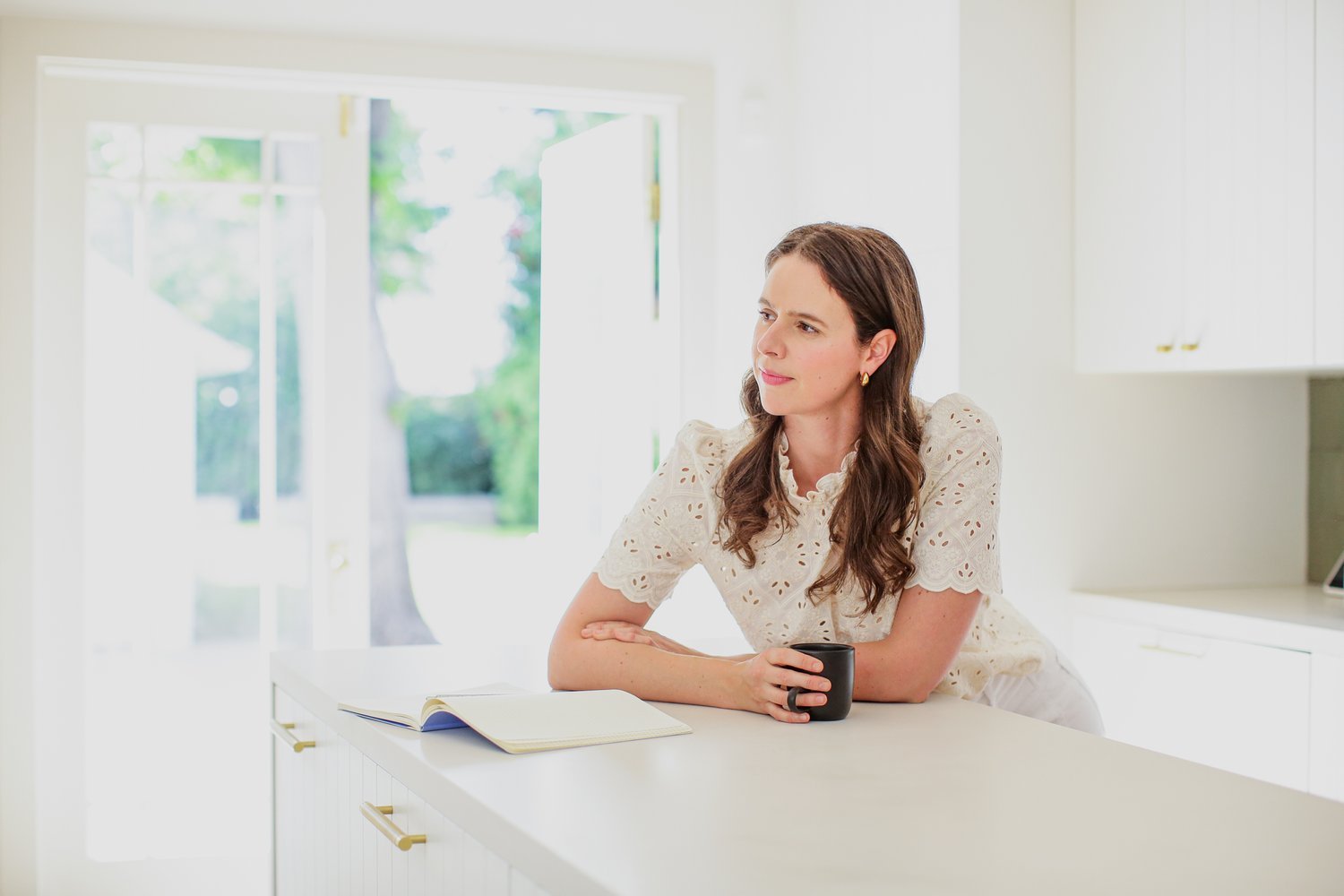Blog
What I tell clients who struggle to take breaks
Here’s something I’ve been saying to seemingly all of my clients recently:
“What if you feel like garbage when you do it…
…and *nothing* is wrong?”
We may know that we need to close our laptops at 6 pm so we can rest + rejuvenate…
Or stop accepting meeting requests from that low-priority project…
Or walk our dog in the middle of the day so we can clear our heads and come back mentally sharper…
… And we may feel like absolute garbage when we do it.
Jumpy in our bodies.
Minds racing.
Worried that we are making a terrible mistake, or that someone will be super mad at us.
This is a tough situation. These actions (closing the laptop, turning down the meetings, walking the dog) are supposed to make us feel better. Is something wrong, if they make us feel absolutely terrible?
The answer is clear: No.
No, nothing is wrong. In fact, it's completely normal to feel like absolute garbage the first 5 times we do something that is hard + scary + out-of-the ordinary for us.
Of course, we can take action to feel less jumpy or mind race-y (see also: journaling, lying on the floor). But even if we do all the positive personal development in the world, it may still take at least 5 times, or 10 times (and occasionally more), before our nervous system + our mind calms down enough for us to reap the full benefits of those activities.
What if it could feel terrible and garbage-y… and nothing could be wrong?
…
As always, I’m rooting for you in the week ahead.
Katie
p.s. Would you like to work with me 1:1? My clients do higher quality work with less time and effort, change careers, finally write that screenplay, make more money, cultivate deeper friendships, and improve their marriages.
And, even more importantly, they feel: clearer about their paths and their values, more confident, more satisfied, and like they have more energy, calm, meaning, and joy.
Learn more here.
Want to receive essays like this every Sunday morning? Sign up for my newsletter!
How to feel sad in a useful way
One of my clients had been feeling “bad” for a long time.
This client was a C-suite executive at a major regional organization, and a highly competent professional.
But he was also completely overwhelmed at work, and exhausted all day. He had so much anxiety in his body, that he’d stopped feeling his body at all. He spent all day in his (very smart) head.
This client was desperate to feel better — understandably!
And yet, one of the first things I told him was: “You need to focus on processing your feelings.”
He balked at this. “I feel all the time!” he told me. “If I come home from work and my wife’s not there, all I do is feel anxious. All of my thoughts and worries and anxieties come rushing back in.”
And that was exactly what I feared.
One thing that I have observed — which I think is not said often enough — is that we can “feel bad” frequently — but without actually processing that emotion.
You will know that you are actually processing your emotion when you feel some amount of relief afterwards. There is an experience of metabolizing the feeling — allowing it to flow through you, and become something different.
You might not feel joyful and sparkly afterwards – but you will feel a sense that the intensity is at least somewhat less than before (and, typically, significantly less).
This often requires inhabiting the feeling or sensation much more deeply and directly than you are doing now.
And something miraculous typically occurs when we do this: not only do we feel much better, we also often get useful insights about our lives: information about what we do and don’t want, or what next actions to take.
…
Learning how to process emotions can take some time — it’s subtle and iterative, and something I often do with my 1:1 life coaching clients — but today, I wanted to share a few prompts to begin that process:
Close your eyes, take a few deep breaths, and call to mind an emotional or physical sensation you’ve been avoiding.
Notice what that feeling is like in your body. Is it a tightness in your chest? A zinging in your belly? A rock in your throat?
(If you can’t feel anything, don’t worry. Many people feel numb at first and unable to access physical sensations. But as virtually all of my clients would attest, it can be learned.)Do not try to change the feeling, push it down, or make it go away. Just let it be there, however it happens to be.
Mentally tell that feeling: You can stay as long as you’d like, and become whatever you want to become — bigger, smaller, something different.The key is then to sit with that sensation, and give it all of the space it needs. I like to imagine kindly giving the feeling an enormous, spacious room to be in, or a wide field. Sometimes it may feel like the feeling gets bigger, more intense. Sometimes new feelings will arise.
Allow each feeling to arise, becoming whatever it needs to be. Typically after several minutes of this, you will start to feel better.
When I did this with my (admittedly skeptical) client – he looked at me afterward with some surprise: I feel better, he told me.
…
So many of us spend our lives feeling low-grade bad, but we avoid those feelings for obvious reasons: If we felt them more directly, we’d feel more bad, right?
And yet, the opposite is typically true: when we feel them directly, we end up feeling better, not worse. Typically, the feelings never last as long as we expect them to.
But the only way around them is through them.
And if you take one thing away from this essay let it be this:
If you’ve been feeling bad, for a long time, it might be time to point your compass directly towards the swamp of messy feelings.
You might blow your mind.
…
As always, I’m rooting for you in the week ahead. You’ve got this.
Katie
p.s. My past and current clients are probably smiling as they read this essay: few of my clients can escape working with me, without learning how to process feelings and sensations better. Almost all of them become less afraid of intense feelings and more capable of moving on from them more effectively.
If you’ve been feeling low-level (or high-level) “bad” for a long time, I’d highly recommend working with me 1:1. The first steps are here.
Sign up for my newsletter to get helpful + encouraging essays like this every Sunday morning. It’s free!
What is somatic awareness and how should you use it?
In my early twenties, in the middle of a quarter-life crisis, my brother suggested I work with a coach.
I guess it could be useful, I thought to myself. Maybe she’ll help me figure out what I should do for my next job.
Oh, I was in for a treat.
I learned many, many things from working with my coach (and that experience is one of the reasons I’m now a coach myself), but one of the most powerful was the power of somatic — or body-based — awareness. Up till then, I’d been a pretty smart, intellectual person, making most decisions using some kind of detailed pro-con list that I analyzed in my mind.
Somatic awareness, which basically just means being aware of the body’s feelings or sensations, totally changed my decision-making process — and is a huge part of how I now work with clients myself.
I wanted to share more about what somatic awareness is, why it’s so incredibly useful, and how you can cultivate it, so I made you a video.
Whether you’ve heard of “somatic awareness" before, or it sounds kind of hippy-dippy and weird, I think you’ll enjoy the video :)
Also! If you haven’t spent much time paying attention to your body’s physical sensations beyond, say, noticing that you feel sore after a hard workout, it can be hard to know where to begin. That’s part of why I don’t talk about this as much on my blog — it’s much easier to explain in an interactive context, like in my group and individual client work.
But this list of sensations, by Larissa Noonan, is a great place to start, if you’re working on your own — she does a great job of putting together a vocabulary of physical sensations. You might complete the sentence: I feel _____ in my ______. For example: I feel buzzy in my chest, I feel hollow in my belly, I feel prickly in my back.
As always, I’m rooting for you. You’ve got this.
Katie
Superfans may notice that I originally shared this essay back in 2018. While I’m on maternity leave, I’m sharing some of my best posts from my archives — I hope you enjoy! :)
If this essay resonated with you, you'll love my newsletter. Sign up for free + get new ideas every Sunday!


